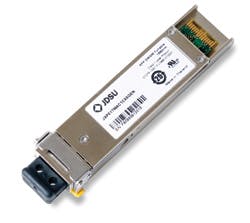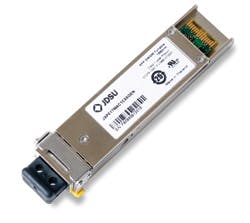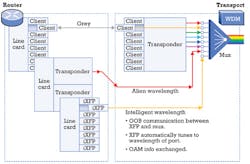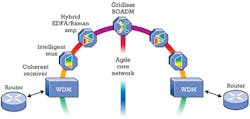By JIM THEODORAS
Long have network architects dreamt of an agile intelligent optical transport layer – and the latest network usage trends are transforming that dream into a competitive necessity. With bandwidth consumption exploding, prices charged per bit collapsing, and peak-to-average bandwidth ratios worsening, no less than a paradigm shift is required at the foundation of network architectures. Complexity, rigidity, and overprovisioning are being left behind. In their place, efficiency and agility are emerging as hallmarks of core transport.
Are we there yet?
Intelligent switching’s benefits have been clearly demonstrated, as Ethernet switches at Layer 2, packet routers at Layer 3, flow routers at Layer 4, and high-performance computers, servers, etc., at higher layers have grown ever larger and smarter. Yet, there sat the optical transport layer – Layer 1 – static for far too long.
Over a decade ago, it appeared that early Generalized Multi-Protocol Label Switching (GMPLS) and Optical Transport Network efforts would bring much-needed intelligent optical switching, but then WDM arrived and threw a monkey wrench into planning. The main impediment to optical switching in WDM has been the need to deal with colors.
It was long thought that tunable transmitters would provide the solution. After much industry investment and creative energy, tunable transmitters arrived – only to have carriers discover that once a color was changed it was blocked at the first multiplexer encountered. Consequently, tunable lasers became merely an efficient way to reduce transceiver inventory.
Next, reconfigurable optical add/drop multiplexers (ROADMs) were seen as the solution: If only tunable lasers were mated to ROADMs, finally an intelligent optical network could be realized. Again, after much industry investment and effort, ROADMs appeared – only for the industry to find that configuration rules could still cause blocking. Out came colorless and then “contentionless” ROADMs – only to find that, after a network was switched, span budgets were likely to be unmet.
with optical transport gear, a third method has emerged: The use of intelligent pluggable optics now enables automatic wavelength assignment.
Thus the promise of an agile core transport network has always seemed just out of reach. But the dream has finally become reality, thanks to convergence of key technologies. Let’s take a look at them.
Tunable transmitters
While tunable lasers aren’t new, their performance has advanced orders of magnitude since early prototypes. Today’s tunable lasers are more wavelength-stable, have better dispersion characteristics, and recently made the leap to pluggable optics, which enables direct integration into switching/routing equipment. But while tunable pluggable optics have continued to get smaller, from XENPAK to XFP form factors, the real advance of using them intelligently has only recently occurred.
Traditionally, there have been two ways to interconnect Layer 2/3 Ethernet switch/routers to Layer 1 optical transport equipment and assign colors to data streams (see Figure 1).
Connecting a router’s grey client port to a transport-gear transponder is the first, most common method. A transponder converts an ingress grey signal to a colored egress signal with the appropriate optical properties to meet reach requirements. That allows denser client-port line cards to be used in routers and makes transport equipment fully aware of color assignment, as it occurs in the same shelf. But the router is unaware of color assignment in the transport gear, and adding two more client optics per data link is inefficient.
The second popular method is to integrate the transponder into the router itself. The color signal is directly input into the color multiplexer of the optical transport gear as an “alien wavelength.” That solves the inefficiency of redundant client ports and enables routers to assign wavelengths. But as the name suggests, the color is “alien” to the transport gear and can be problematic over long-distance links. During initial installation, the color of the signal from the router must be carefully cabled to matching ports on the transport gear.
But perhaps the greatest shortcoming is that transponders have much lower port density than client cards. For example, the same router slot that will accept a 48-port client line card may only offer four ports when configured as a transponder. Given the cost and power of typical router card slots, that’s poor resource use.
At last, there’s a third option. Thanks to the latest intelligent pluggable tunable optics, it’s now possible to realize the traditional approaches’ benefits, without the disadvantages. These new optics can be directly plugged into the client ports of customer premises routers, making full use of each slot. The outputs of these intelligent pluggables are brought into transport equipment at the optical multiplexer, but now the colors aren’t alien at all. The pluggable optics in the router exchanges information with transport gear in an out-of-band communication path, thus conveying the benefits of using transponders in transport gear. Installation is greatly simplified, since any router port can be cabled to any transport port, and each pluggable automatically tunes to the proper channels.
ROADMs
ROADMs, too, have advanced several orders of magnitude since early incarnations. With the realization of ROADMs came the desire for colorless operation; with colorless ROADMs came the need for directionless operation. As ROADMs have advanced, so have network architects’ demands.
One impediment to agile core networks – and a source of network architects’ frustration – has been the paradox noted previously: If a ROADM switches a wavelength, the new network configuration often no longer meets span-design requirements. The only solution is to pre-design the entire network’s span parameters for any conceivable ROADM switched path. But this strategy renders the network so over-designed that it is no longer viable.
Recently, advances in hybrid amplifiers and coherent detection have increased link budgets to the point that this limitation is eliminated. With high-span-budget technologies, ROADMs now can switch at will and are free to grow more flexible.
ROADMs’ latest frontier is gridless operation, whereby any portion of color space of an ingress signal can be routed to any output port. The benefit here is far greater than sparing. Simply running gridless can free 25% more bandwidth in a fiber – for free..
The standard grid of wavelengths poorly fits today’s fiber-optic links, which carry complex mixes of 10G, 40G, and 100G data rates – each potentially with different spectral widths due to different modulation approaches (ODB, DPSK, QPSK, etc). Substantial bandwidth is wasted between the edges of signals and channel allotments. With gridless operation, a minimum guardband can be maintained between signals, depending on the actual spectral width of the signal carried.
Coherent detection
Coherent detection, specifically the intradyne type used in optical transport, is in its infancy and relatively expensive compared to non-coherent alternatives. But the technology has indisputably been a game changer – in more ways than one.
The most widely acknowledged benefit of coherent detection is extra link budget, yielding the aforementioned removal of span constraints. Without coherent detection, when a network link is switched, the path being switched to must meet network-span constraints; today, that is accomplished by transmitters, ROADMs, and amplifiers together maintaining delicate optical balance. Coherent detection greatly simplifies the meeting of span constraints before and after network reconfigurations.
However, the ability to conquer other impairments such as chromatic dispersion (CD) and polarization-mode dispersion (PMD) in the digital domain shouldn’t be overlooked. Without such digital filtering capabilities, data rates would be stuck at 40 Gbps for the conceivable future. The bane of network architects at 10G was CD; at 40G, PMD caused migraines. Digital filtering techniques have turned CD and PMD into “don’t cares.” The leap is so large with coherent detection, many Tier 1 carriers globally have ripped spools of dispersion compensating fiber (DCF) from their networks.
Hybrid amplification
High-gain, multistage EDFAs are typical today, but their gain does not come for free; the optical noise and gain slope introduced require complex, expensive compensation techniques. Because DCF is unnecessary in coherent detection, simpler low-noise EDFA designs can be leveraged. Raman amplifiers – using fiber spools or the existing fiber plant as gain medium – are sometimes used to supplement a link’s gain.
EDFA and Raman technologies can be used cooperatively for maximum benefit. While EDFAs deliver substantial gain but across a small color band, Raman amplifiers provide more modest gain across a wide color band. An optimized egress EDFA may be used to maximize send-signal strength at the start of a bidirectional link between two core routers; at the end, a counter-propagating ingress Raman amplifier can boost the receive signal. Small EDFA gain blocks also may be integrated into ROADM receive paths at a link’s mid-span nodes, yielding sufficient loss budget for any configuration requested.
Coherent detection’s gain and digital filtering reduce the need for optical gain and in turn allow use of smaller distributed amplifiers. The greatly simplified span-design constraints give ROADMs the freedom to switch wherever necessary.
Control plane interoperability
So now that true optical-network flexibility exists, what to do with it?
The transport network doesn’t have enough self-awareness to make appropriate decisions. Sure, it can provide protection switching based on either optical power levels or monitored error correction rates. But real intelligence resides at higher layers. That’s why control plane interoperability between the routing/switching and optical transport layers is so important. To achieve a truly agile core network, commands must be executable across multiple domains.
The IP layer typically uses MPLS to control packet flow and guarantee the deterministic behavior needed in carrier-scale networks. The physical transport layer adapted that standard and evolved it to a more generalized version (GMPLS) that follows the same principles and provides control plane intelligence for wavelengths, timeslots, and more recently Ethernet frames. In most cases, IP and physical layers communicate via a user network interface standardized by the Optical Internetworking Forum.
Perhaps the best way to demonstrate the importance of control plane interoperability is to examine its converse example. Walk up to a transport network, unplug a cable, and watch chaos ensue. One potential scenario is that physical transport (Layer 1) will lose light and start protection switching. The data-link layer (Layer 2) will see framing loss and might begin flooding all ports. The IP layer (Layer 3) will see packet loss, start fast reroute procedures, and maybe even try re-converging on a new network configuration. In the “transport layer” (Layer 4), any TCP sessions will time out and begin resending packets. When done in isolation, all these events fight one another, making the situation worse. When done together, intelligently, in orderly fashion, the cable pull is transparent to end users.
Admittedly, fault protection is the first benefit that comes to mind when discussing control plane interoperability. But that barely touches the surface. When router/switches and optical transport gear work together, an end user can perform simple point-and-click operations that launch automated end-to-end inventory, discovery, reservation, and setup of optical circuits. One click of a mouse in a router’s graphical user interface can set hundreds of control messages into motion in the optical transport equipment to ensure desired data-center connections across an agile core network, whereby traffic is automatically rerouted around issues and bandwidth is dynamically provisioned when, where, and as it is needed (see Figure 2). The simplicity and flexibility conveyed to network operators is revolutionary.
Agile at last
Network operators’ economic viability today depends on evolving beyond inflexible legacy architectures that don’t scale easily and network growth strategies predicated on simply adding more switch/routers and protocol layers. The agile core – finally achievable with the convergence of a host of innovations – conveys to network architects unprecedented flexibility to provision optical infrastructure-as-a-service applications, scale gracefully, and optimize resource utilization.
JIM THEODORAS is senior director of technical marketing at ADVA Optical Networking.
Past LW Articles



